|
120. Boloria aquilonaris (Stichel, 1908) / Cranberry fritillary / Nymphalidae –Heliconiinae
NL: veenbesparelmoervlinder / D: Hochmoor-Perlmutterfalter / F: nacré de la canneberge
 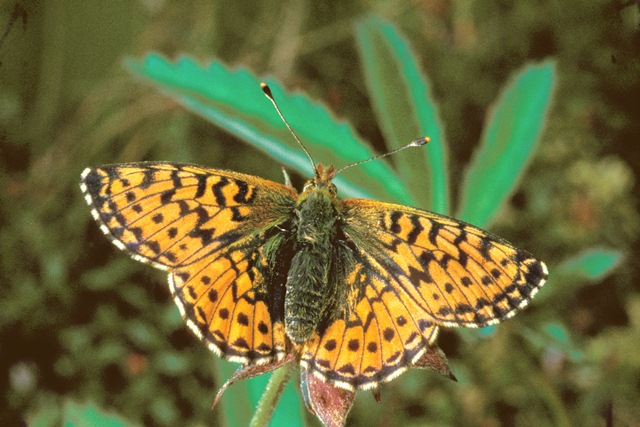 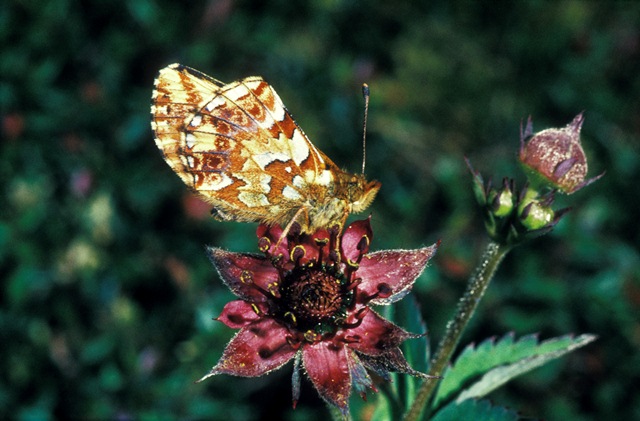
Photographs: Frits Bink ©.
Small or medium-sized, wing length 19 (17-21) mm. The occurrence of this species in the Benelux can be considered as a relic of post glacial climate periods. The species is known from several localities in the mountainous climate zone of the Ardennes and also from lowland raised bogs in the province Drenthe in the Netherlands. In this area the species is considered as a species typical of raised bogs.
Butterfly is on the wing from mid-June until end-July and peaks early and mid-July. The species is known from subcontinental to severe continental climates, amplitude 7 to 18. Required heat sum 100°d and maximum tolerated 800°d, corresponding climate windows 12 and 25 weeks.
This species of the taiga and tundra and mountainous landscapes is, in the Netherlands, only known from raised bogs in the western part of Drenthe, not from the historic 1600km² bog complex Boertangermoor, of which the reserve Bargerveen is an existing relic. In 1993 an unsuccessful introduction trial was carried out there (Bos et al. 2006: 315). In Belgium the species has been studied in the area of 220km² on the Baraque de Fraiture and its surroundings on the Plateau des Tailles in 1995 and 1996 by the capture and recapture method. The results concerning the spatial movements of the butterflies proved that males can migrate more than one kilometre and that 12 populations can occur on sites of 1500-2000m² (Mousson, Nève & Baguette 1999).
Ecological characteristics
Behaviour over time
Overwintering: newly hatched larva of 1.5 mm in length, hidden in the moss layer.
Reproduction: oviposition starts after 3-4 days when the body contains 67 (65-69) eggs, estimated potential production 1.6 times as much.
Larval feeding periods: in spring and early summer 60 (58-65) days from early April until end-June.
Generations: one.
Spreading of risk: not observed.
Life cycle: egg 25 (22-35) days; larva 43-47 weeks; pupa 14 (10-18) days.
Life span of adult: short, 2 weeks.
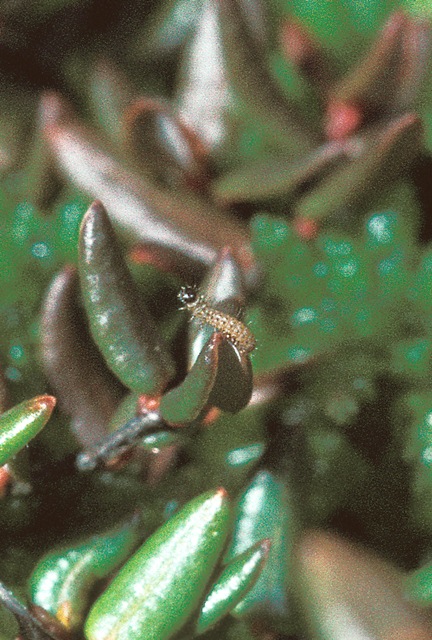 
Photographs: Frits Bink ©.
Behaviour in space
From stay-at-home to migrant: stay-at-home, spatial requirement modest.
Finding a mate: male patrols.
Orientation in the landscape: open landscape of medium tall vegetation with moss cushions.
Oviposition: on the underside of the leaf of its host-plant.
Defence
Threats from other organisms: the larva is armoured with bristles and avoids predators by hiding.
Threats from the environment: the species is only know from humid habitats, so are vulnerable to drought and heat.
Feeding habits
Adult: nectar, preferred flowers are Comarum palustre (also preferred as roosting place) and Arnica montana.
Larva: feeds on buds, flowers and young shoots. The larva basks hidden in the vegetation.
Larval foodplants
Plant species: Ericaceae, Andromeda polifolia, Vaccinium oxycoccus.
Journal
Rearing experiment based on specimens from Dwingeloo, Lange Veen, Netherlands:
19 June 1982: seven butterflies captured.
25 June: one female had laid 40 eggs.
1 August: no feeding of the larvae observed.
Overwintered outdoors.
13 March 1983: taken indoors.
23 March: four larvae found which had left the tussock and dropped into the water of the container.
3 April: feeding larvae seen, they ate bursting buds during the day.
8 April: larvae at end of first instar.
18 April: biggest larva end second instar.
24 April: biggest larva third instar. One larva found under a leaf on the sunny side and one killed by a spider.
8 May: larva early fourth instar, signs that the food quality is unsuitable, a new plant was offered and accepted.
15 May: larva in moult L4-5, basked during the day, half hidden under a leaf.
23 May: larva nearly fully grown, wandering around and ate bursting buds shoots and flowers, hid at night in a grass tussock and basked during daytime, half hidden in the vegetation.
1 June: pupated.
11 June: female appeared, egg load fully developed 27 eggs.
Table 120-1. Results of dissections

Table 120-2. Collection and observation localities
DK, Tofte Mose, 56° 50’39”- 10° 11’ 11”E; 5 July 2005.
EST, Valge raba, 58° 26’ 29”N – 25° 14’ 09”E; 8 July 1999.
F, Vosges, Chaume du Tanet, 1200 m, 48° 05’ 20”N – 7° 03’ 12”E; 26 July 1983.
F, Vosges, Tourbière de Machais, 980 m, 48° 00’ 21”N – 6° 57’49”E; 24 July 1983, 23 August 1984.
NL, Dwingeloo, Lange Veen, 52° 48’ 58”N – 6° 25’ 44”E; 19 June 1986.
NL, Schoonloo, ven 61, 52° 54’ 24”N - 6° 40’ 01”E; 22 June 2005.
S, Tännäs, 62° 26’ 29”N – 12° 41’ 20”E; 15 August 1985.
Fig. 120-1. Boloria aquilonaris, phenogram adapted from Fichefet et al. 2008: 180.
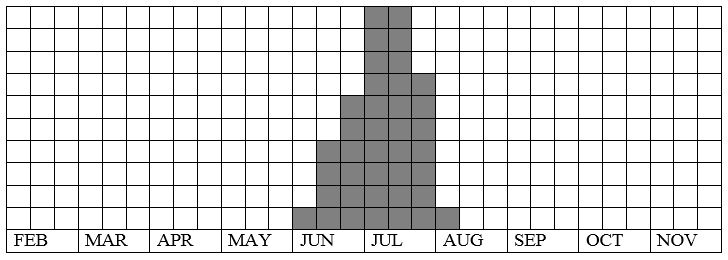
Fig. 120-2. Boloria aquilonaris, habitat characteristics.
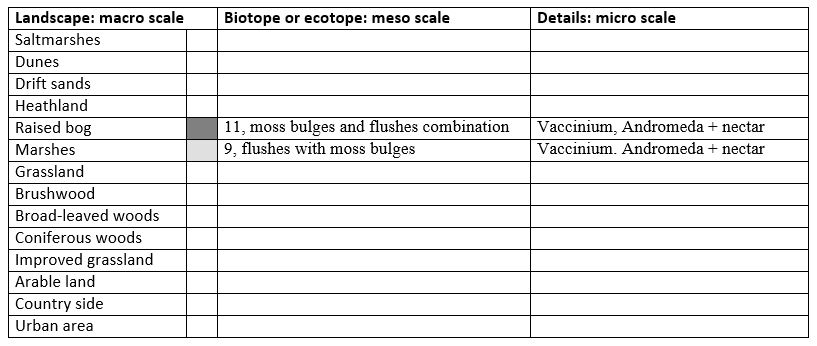
Fig. 120-3. Boloria aquilonaris, climate matrix, heat-sums 100 - 800°d.
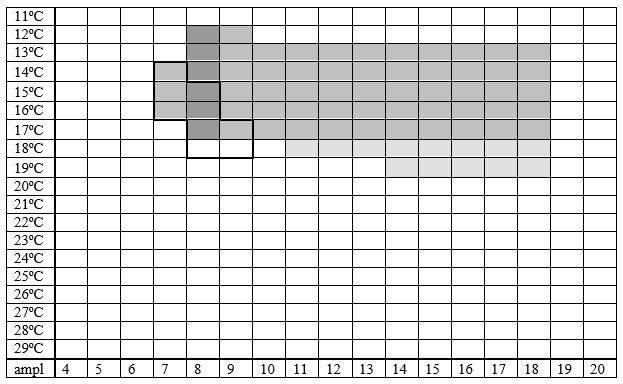
|










